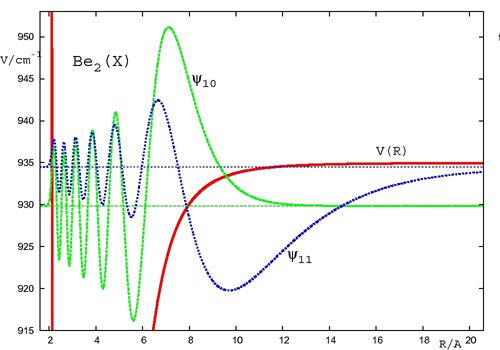
Department of Chemistry and Biochemistry
Professor and Graduate Program Officer (GPO)
Research Areas: Physical
Office: 116 Extension Hall
Phone: (344) 844-7522
Email: patkowsk@auburn.edu
Theoretical and computational study of weak intermolecular interactions
Intermolecular interactions are everywhere. A network of intermolecular hydrogen bonds determines the properties of liquid water and aqueous solutions. Hydrogen bonds as well as other effects (like stacking interactions of aromatic side chains) govern the structure of proteins and the catalytic abilities of enzymes. Even the least reactive species like rare gas atoms exhibit weak mutual attraction due to a phenomenon called dispersion. In fact, this attraction is the very reason why rare gases form liquids and solids at low temperatures.
In a computational study of the interaction between two atoms or molecules, the key quantity is the potential energy surface (PES). This surface represents the electronic interaction energy of the dimer as a function of the intermonomer distance and of the relative orientation of monomers. Once the PES is known, we can calculate various quantities (spectra, virial coefficients, liquid and crystal parameters) that can be compared to experimental predictions.
The interaction energy at a given geometry is usually calculated in the so-called supermolecular manner: you pick your favorite quantum-chemistry electronic-structure theory, compute the energy of the dimer AB, and subtract the energies of monomers A and B. This subtraction can be tricky - the result is orders of magnitude smaller than the energies you subtract (it is like weighing a person by placing her on a large, fully loaded ship, and weighing the ship with and without her). Moreover, the result of the subtraction (a single number) does not really tell much about the underlying physics of the interaction. A useful alternative to the supermolecular approach is provided by symmetry-adapted perturbation theory (SAPT) where the interaction energy is calculated directly (no subtraction) as a sum of low-order terms in a perturbation series. Each of these terms has a clear physical interpretation and corresponds to an electrostatic, induction, dispersion, or exchange effect. The supermolecular and SAPT methods nicely complement each other and it is often useful to employ both approaches (as well as several different electronic-structure methods) to construct and interpret accurate PESs. Obviously, the larger the dimer, the more approximate methods have to be used. More accurate approaches tend to scale steeply with the system size and require a lot of CPU time and memory even on powerful supercomputers.
Specific topics addressed by the research in our group include
- further development of the SAPT methodology and software, in particular, application of SAPT to interactions of open-shell systems like radicals or transition-metal atoms and complexes,
- computational studies of simple molecules that are physisorbed (that is, bound by intermolecular forces, primarily dispersion) on metallic and graphite/graphene surfaces,
- development and applications of ultra-accurate PESs for weakly interacting atoms or small molecules.

- Patkowski, K. Recent Developments in Symmetry-Adapted Perturbation Theory, WIREs Comput. Mol. Sci. 2019, e1452
- Hemmati, R.; Patkowski, K. Chiral Self Recognition: Interactions in Propylene Oxide Complexes, J. Phys. Chem. A 2019, 123, 8607
- Kodrycka, M.; Holzer, C.; Klopper, W.; Patkowski, K. Explicitly correlated dispersion and exchange dispersion energies in symmetry-adapted perturbation theory, J. Chem. Theory Comput. 2019, 15, 5965
- Kodrycka, M.; Patkowski, K. Perspective: Platinum, gold, and silver standards of intermolecular interaction energy calculations, J. Chem. Phys. 2019, 151, 070901 (Journal Cover)
- Waldrop, J. M.; Patkowski, K. Spin splittings from first-order symmetry-adapted perturbation theory without single-exchange approximation, J. Chem. Phys. 2019, 150, 074109
- Pimienta, I. S. O.; Patkowski, K. Heats of formation and thermal stability of substituted 1,1'-Azobis(tetrazole) compounds with an extended nitrogen chain, Int. J. Quantum Chem. 2019, 119, e25794 (Journal Cover)
- Smith, D. G. A.; Burns, L. A.; Sirianni, D. A.; Nascimento, D. R.; Kumar, A.; James, A. M.; Schriber, J. B.; Zhang, T.; Zhang, B.; Abbott, A. S.; Berquist, E. J.; Lechner, M. H.; dos Anjos Cunha, L.; Heide, A. G.; Waldrop, J. M.; Takeshita, T. Y.; Alenaizan, A.; Neuhauser, D.; King, R. A.; Simmonett, A. C.; Turney, J. M.; Schaefer, H. F.; Evangelista, F. A.; DePrince III, A. E.; Crawford, T. D.; Patkowski, K.; Sherrill, C. D. Psi4NumPy: An Interactive Quantum Chemistry Programming Environment for Reference Implementations and Rapid Development, J. Chem. Theory Comput. 2018, 14, 3504
- Dutta, N. N.; Patkowski, K. Improving 'silver-standard' benchmark interaction energies with bond functions, J. Chem. Theory Comput. 2018, 14, 3053
- Patkowski, K.; Żuchowski, P. S.; Smith, D. G. A. First-order symmetry-adapted perturbation theory for multiplet splittings, J. Chem. Phys. 2018, 148, 164110
- Song, B.; Waldrop, J. M.; Wang, X. P.; Patkowski, K. Accurate virial coefficients of gaseous krypton from state-of-the-art ab initio potential and polarizability of the krypton dimer, J. Chem. Phys. 2018, 148, 024306
- Thibault, F.; Patkowski, K.; Żuchowski, P. S.; Jóźwiak, H.; Ciurylo, R.; Wcislo, P. Rovibrational line-shape parameters for H2 in He and new H2-He potential energy surface, J. Quant. Spectrosc. Radiat. Transf. 2017, 202, 308
- Patkowski, K. Benchmark Databases of Intermolecular Interaction Energies: Design, Construction, and Significance, in Annu. Rep. Comput. Chem. (Dixon, D. A., Ed.) Vol. 13, Amsterdam: Elsevier, 2017, pp. 3-91
- Parrish, R. M.; Burns, L. A.; Smith, D. G. A.; Simmonett, A. C.; DePrince III, A. E.; Hohenstein, E. G.; Bozkaya, U.; Sokolov, A. Yu.; Di Remigio, R.; Richard, R. M.; Gonthier, J. F.; James, A. M.; McAlexander, H. R.; Kumar, A.; Saitow, M.; Wang, X.; Pritchard, B. P.; Verma, P.; Schaefer III, H. F.; Patkowski, K.; King, R. A.; Valeev, E. F.; Evangelista, F. A.; Turney, J. M.; Crawford, T. D.; Sherrill, C. D. Psi4 1.1: An Open-Source Electronic Structure Program Emphasizing Automation, Advanced Libraries, and Interoperability, J. Chem. Theory Comput. 2017, 13, 3185
- Smith, D. G. A.; Burns, L. A.; Patkowski, K., Sherrill, C. D. Revised Damping Parameters for the D3 Dispersion Correction to Density Functional Theory, J. Phys. Chem. Lett. 2016, 7, 2197
- Li, S.; Smith, D. G. A.; Patkowski, K. An accurate benchmark description of the interactions between carbon dioxide and polyheterocyclic aromatic compounds containing nitrogen, Phys. Chem. Chem. Phys. 2015, 17, 16560
- Waldrop, J. M.; Song, B.; Patkowski, K.; Wang, X. P. Accurate ab initio potential for the krypton dimer and transport properties of the low-density krypton gas, J. Chem. Phys. 2015, 142, 204307
- Smith, D. G. A.; Patkowski, K. Benchmarking the CO2 Adsorption Energy on Carbon Nanotubes, J. Phys. Chem. C 2015, 119, 4934
- Smith, D. G. A.; Jankowski, P.; Slawik, M.; Witek, H. A.; Patkowski, K. Basis set convergence of the post-CCSD (T) contribution to noncovalent interaction energies, J. Chem Theory Comput. 2014, 10, 3140
Last updated: 11/15/2024
